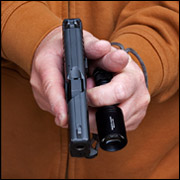To further define the ideal attributes of a "fight light" that differentiate it from an "everything else" EDC flashlight, we must consider how to create an effective photonic barrier and any temporary flash blindness that can be achieved.
The brightness of a light source is measured in luminous intensity. For a flashlight, candela is the measure of luminous intensity;
Luminous flux is the measure of light output in all directions, the common "lumen" rating of flashlights. The lumen rating of a flashlight does NOT indicate how bright it is, only the total output of the light source in all directions. So in predicting how effective a flashlight will be for creating a photonic barrier and depriving an assailant of their ability to see where we are or what we're doing, it's the candela (cd) rating that needs to be considered.
So how much cd is needed to be effective in real life defensive situations?
A few years ago I had the opportunity (and pleasure!) to work with a LEO P-F member who was a warrant officer at the time. He had reached out to me for advice on a light to be used in warrant arrests, specifically the use of the light to more quickly subdue suspects who weren't going to cooperate. We started with a Malkoff M91T head (750 lumen | 20,000 cd) and he found that this level of brightness was pretty effective inside rooms that were not brightly lit. Looking to go a step further, he purchased a Modlite OKW (680 lumen | 69,000 cd) and found that when the narrow beam was directed into the eyes it was devastatingly effective. The problem was that the 69k cd hot spot was not very wide, so he then tried the Modlite PLHv2 (1,350 lumen | 54,000 cd) and found that the wider (though less intense) hot spot worked better for his application.
So based on this, I would say for the civilian fight light, we should consider 20,000 cd as the minimum.
Mirror Testing
There's nothing like being subjected to bright light yourself to see first-hand how blinding it is. Using a mirror about 12 feet away (equal to 24 feet distance between user and assailant), as I climbed the ladder to higher and higher cd lights, the effect became increasingly effective. It's very difficult to look past a 20,000 cd beam, and it's downright painful to even keep the eyes open at 70,000 cd. Keep in mind that brightness is inversely proportional to distance, but I think judging blinding effectiveness at around 21 feet is a reasonable measure.
One of the trade-offs of high cd flashlights is that as the beam becomes more focused, the more narrow the high cd hot spot becomes and the more difficult it becomes to keep the beam in the eyes of the assailant (this is what my warrants officer friend had observed as well). So the ideal fight light beam is going to have a beam brightness of at least 20,000 cd with as wide of a hot spot as possible. This is where the lumen rating finally has some meaning: more lumens can be used to expand the size of the hot spot. Here's an example - using the 1,700 lumen | 70,000 cd Malkoff Hound Dog Super vs. the Malkoff E2XTD 650 lumen | 70,000 cd head, the Hound Dog Super is not brighter, but the hot spot is wider giving broader "blinding" coverage. Of course, this Hound Dog Super is physically way too large for civilian concealed EDC.
Another trade-off of high cd beam is that it's far from ideal for all of those mundane tasks an EDC flashlight is typically used for. Illuminating something in the hand with a 750 lumen | 20,000 cd beam is blinding, but with a 800 lumen | 5,000 cd beam not nearly as much. For these mundane tasks, a low-cd flood beam is ideal.
Conclusion
In order to fully leverage the benefits being discussed in this thread of a handheld fight light, it needs to be configured in a fashion that renders it impractical for mundane EDC flashlight use. But having the handheld fight light for SA and defensive use is IMO well worth the very small effort to carry two lights.
Photo 1: 550 lumen | 44,000 cd fight light on the left, 800/5 lumen SF E2T-MV (low cd flood pattern) on the right;
Photo 2: 500 lumen | 35,000 cd Malkoff E2HT EDCLB Dagger fight light;







 Reply With Quote
Reply With Quote









